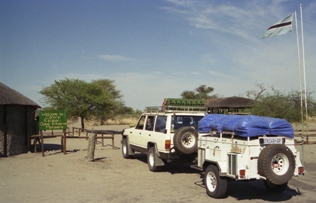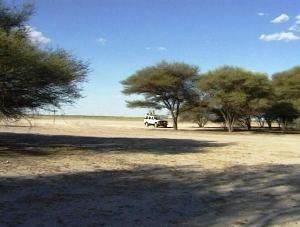Self Drive
4x4 Africa Adventures
- Home
- Botswana
- Zimbabwe
- Mozambique
- Travel Channel
- Contact Us
Central Kalahari Game Reserve - Botswana



At 52 800 square km, Central Kalahari Game Reserve, referred to as CKGR, is the second largest game reserve in the world. Larger than Lesotho and Swaziland combined.
A desert in name, the CKGR supports diverse habitats - from salt pan to savannah. The land is home to at least 64 species of mammals and 250 types of birds.
Meandering through these great open spaces are four fossil river valleys - the most famous being Deception.
Countless pans and dunes are concentrated in the northern third of the Reserve.
The roads around Deception are in excellent condition, but could become slippery during the wet season and 4 wheel drive might be necessary.
It is here in Deception Valley where Mark and Delia Owen researched the brown hyena for 7 years. Their book "Cry of the Kalahari" makes excellent reading.
The valley is scattered with islands of trees. Here on one of these islands, the Owens have put up camp.
The world-renowned San people have lived in this area for perhaps 30 000 years.
Originally the reserve was set up in 1961 to protect the natural resources on which the Bushmen (San) hunter-gatherer-lifestyle depended.
As there is little or no surface water, the game rely on artificial water holes scattered through the park.
Other than Deception, these water holes offer good game viewing like those at Sundays Pan and Letiahau.
After good rains, the harsh landscape is transferred into a green haven for thousands of springbok, gemsbok and wildebeest.
Giraffe, cheetah, hyena, jackal and lion also roam the valley.
Road to Central Kalahari Game Reserve
Botswana lies at the center of the Southern Africa plateau and covers an area of approximately 582 000 square km. It borders Zambia, Namibia, South Africa and Zimbabwe.
Between 70 and 80 percent of the country is covered by Kalahari Desert. Here the vegetation varies from bushy, grass to bare sand.
Botswana has approximately 15 000 km of roads. Recently many kilometers of road have been tarred. The rest are gravel, earth- or sand surfaced, and depending on the season, some of them can be in very poor condition
Petrol and Diesel are available on all the main routes throughout the country. Your very last chance to fill up before entering the Central Kalahari Game Reserve is at Rakops.
We suggest that you top up all your water bottles at a communal tap in the center of the village, as there is no water available in the Central Kalahari Game Reserve, except at the Scout Camp at the entrance gate - and the water there is quite brackish.
Here at Rakops the tar ends. Just follow the signposts and after about 50 km on an excellent gravel road, the park entrance is reached.
Road from CKGR to Maun
After an unforgettable visit, we depart for Maun. Turn left at the Entrance Gate and drive along the Reserve Boundary for 22 km, where you reach the vetenary gate at Kuke Corner.
Go through the gate and follow the vet fence for 77km until you reach the village of Makalamabedi.
In stretches the road is very sandy and could require a 4 wheel drive vehicle.
Outside Makalamabedi one crosses the Boteti River where the tar road starts, which joins up with the main Nata-Maun road.
Only 52 km further on we will reach Maun.
Copyright 2014